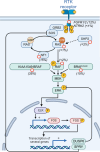MOST wanted: navigating the MAPK-OIS-SASP-tumor microenvironment axis in primary pediatric low-grade glioma and preclinical models
- PMID: 38789691
- PMCID: PMC11511703
- DOI: 10.1007/s00381-024-06463-z
MOST wanted: navigating the MAPK-OIS-SASP-tumor microenvironment axis in primary pediatric low-grade glioma and preclinical models
Abstract
Understanding the molecular and cellular mechanisms driving pediatric low-grade glioma (pLGG)-the most prevalent brain tumor in children-is essential for the identification and evaluation of novel effective treatments. This review explores the intricate relationship between the mitogen-activated protein kinase (MAPK) pathway, oncogene-induced senescence (OIS), the senescence-associated secretory phenotype (SASP), and the tumor microenvironment (TME), integrating these elements into a unified framework termed the MAPK/OIS/SASP/TME (MOST) axis. This integrated approach seeks to deepen our understanding of pLGG and improve therapeutic interventions by examining the MOST axis' critical influence on tumor biology and response to treatment. In this review, we assess the axis' capacity to integrate various biological processes, highlighting new targets for pLGG treatment, and the need for characterized in vitro and in vivo preclinical models recapitulating pLGG's complexity to test targets. The review underscores the need for a comprehensive strategy in pLGG research, positioning the MOST axis as a pivotal approach in understanding pLGG. This comprehensive framework will open promising avenues for patient care and guide future research towards inventive treatment options.
Keywords: MAPK pathway; Microenvironment; Oncogene-induced senescence; Pediatric low-grade glioma; Senescence-associated secretory phenotype.
© 2024. The Author(s).
Conflict of interest statement
T.M. was supported by research grants from Biomed Valley Discoveries, Inc., and Day One Biopharmaceuticals.
Figures





References
-
- Wisoff JH, Sanford RA, Heier LA et al (2011) Primary neurosurgery for pediatric low-grade gliomas: a prospective multi-institutional study from the children’s oncology group. Neurosurgery 68:1548–1554. 10.1227/NEU.0B013E318214A66E - PubMed
Publication types
MeSH terms
Grants and funding
LinkOut - more resources
Full Text Sources
Medical

